Travel
Travel to Hungary
This small country is the size of Indiana and one of the oldest European countries, situated in the middle of the continent in Central Europe.
Hungarians speak a language and form a culture unlike any other in the region: this distinctiveness has been both a source of pride and an obstacle for more than 1100 years.

Hungary is one of the 15 most popular tourist destinations in the world.
Despite its relatively small size, the country is home to numerous World Heritage Sites, UNESCO Biosphere reserves, the second largest thermal lake in the world (Lake Hévíz), the largest lake in Central Europe (Lake Balaton), and the largest natural grassland in Europe (Hortobágy).
In terms of buildings, Hungary is home to the largest synagogue in Europe (Great Synagogue), the largest medicinal bath in Europe (Széchenyi Medicinal Bath), the third largest church in Europe (Esztergom Basilica), the second largest territorial abbey in the world (Pannonhalma Arch abbey), and the largest Early Christian Necropolis outside Italy (Pécs).
Arrival

Most tourists visiting Hungary generally arrive in Budapest by airplane at Ferihegy International Airport’s Terminal 2, which is 24 kilometers southeast of the city center.
There are limousine and car services that can meet you at the airport and transport you to your destination.
Alternatively, you can use the taxi service at the airport (currently Fõtaxi has this contract).
There’s a stand just outside the terminal, and all drivers speak enough English to communicate with passengers, though it may be helpful to have your address already written out to be on the safe side.
Fares are based on the district you’re travelling to, with fares to downtown Pest averaging around HUF5000 and fares to Buda around HUF6000.
Depending on traffic, driving time into the centre of the city runs 20-30 minutes, with travel to Buda taking 10-30 minutes longer.
Due to fraud, we recommend you use only metered taxis.
Do not use taxi’s that have no meters for you risk being charged significantly higher rates.
There are also a number of car rental companies in Budapest, and cars can be picked up at the airport.
You’ll need a valid driver’s license, a passport and a credit card.
If you book online you may receive a discount, and additional insurance is available on all rentals.

Another option is the Airport Minibus, which takes all passengers going to the same area for a flat fee of HUF2100.
You can buy your ticket at the Airport Passenger Service desk.
The city can also be accessed by a city bus that will drop you at Kõbanya Kispest, the last stop at the southern end of the Blue Metro Line.
From Terminal 1, where discount carriers land, there are also regular trains into the West Train Station (Nyugati Pályaudvar), which is in the centre of Pest.
Public transportation
Budapest has an excellent public transit system consisting of subways, buses, trolleys, trams and electric commuter trains called HEV.
Tickets are available at all stations from automated machines, and most stations also have cashiers at ticket windows.
Tickets can also be bought at news stands, tram stops and on some buses.
Tickets can be bought individually, discounted in books of 10 or in the form of daily, weekly or monthly passes.
If you will be using public transit on a routine basis, I would recommend monthly passes.
They are a great deal.
They’re good for all forms of transport and are valid for 30 days from the date of purchase.
You’ll need a passport-size photo; there are photo machines in major Metro stations, with four photos costing HUF700.

If you’re using a ticket as opposed to a pass, you need to validate it before starting your trip on the Metro or immediately upon boarding a bus, tram, and trolley or commuter train.
Insert the ticket into the machines at Metro station entrances and in the red or yellow boxes on trams, buses and trolleys.
The yellow boxes automatically stamp the ticket, but you must pull the black lever on the red boxes towards the ticket to punch it.
Tickets are valid on Metro for 60 minutes after stamping or for 90 minutes on the night service.
Passes and tickets are checked by BKV inspectors at random and you’ll be fined HUF6000 on the spot if you can’t produce your pass or validated ticket.
Public transportation runs from 4:30am through 11pm and is both regular and frequent.
Night trams and buses run on an abbreviated schedule.
Schedules are posted at all stops and detailed system maps are posted in all Metro stations.
Budapest has three subway lines, with a fourth under construction.
The three existing lines converge at Deák Ferenc tér in the heart of downtown Pest, where you can transfer at no additional charge to another line.
The number 1 Yellow Line was constructed for the Millennium Celebrations in 1896 and has been restored to its original style.
It runs east – west through Pest.
The number 3 Blue Line basically runs north and south through Pest, with the number 2 Red Line currently the only one linking Buda to Pest.
The main tram line is the 4/6, which runs from Széll Kálmán tér in Buda, across the Margit Bridge around the large circle road through Pest and back over the Petõfi Bridge to Buda.
Numerous older tram lines run throughout various parts of the city, and the bus and trolley system is extensive.
Tickets are only valid for one trip, so if you need to transfer to another tram, bus or trolley or onto the Metro, you’ll have to validate another ticket.
The number 2 tram runs along the Danube and is a fabulous way to see the city.
The HEV runs to and from Csepel Island and Ráckeve in the south, Szentendre in the north and Gödöllõ in the east.
More information in English: www.bkv.hu/en/

Taxis
Most taxis are clean and reasonably priced, and you should round up to the nearest HUF100 when paying.
The addition of an extra 10 percent tip is appreciated.
While all operators can take orders in English, not all drivers are bilingual (or understand our attempts at Hungarian!) so it’s advisable to write out your destination on a piece of paper.
Avoid hailing a taxi on the street, unless you want to pay almost twice as much as you would by ordering one by phone.
Remember only use metered taxis.
The main companies are:
- City Taxi (211 1111)
- Fõtaxi (222 2222)
- Buda (233 3333)
- Tele5 (355 5555)
- 6×6 Taxi (266 6666)
- Taxi 2000 (200 0000)
- Radio Taxi (377 7777)
Walking in Budapest
Budapest is a fabulous city for walking, with a number of cobblestone walking streets in the central core where vehicles are prohibited.
The main one, Váci utca, runs from Vörösmarty tér (the main square in the heart of downtown) to the Vásárcsarnok (large indoor market hall), and is full of tourists for much of the year.
Pavements on the main avenues are quite wide and cleaned regularly, but beware when strolling on smaller streets, where dog owners do not always pick up after their pets.
There are no pedestrian crossings at most major intersections; instead thru an underground tunnel.
Buda, on the other hand, presents a bit more of a challenge with its rolling hills , but major arteries tend to follow the valleys in between and smaller streets often zigzag, with staircases for pedestrians from one level to the next in the central core.
Driving
Non – EU citizens may drive with their existing driving license for one year, after which they are required to apply for a Hungarian license.
It’s a complicated process that must be done in Hungarian, and requirements may vary from district to district.
You need an application form from your district document office, along with a valid residence permit, a valid foreign driving license along with a Hungarian translation, a passport and a medical examination.
Your best bet is to hire a driving instructor or relocation expert to guide you through the process and acquaint you with the rules of the road in Hungary beforehand.
Driving in Budapest can initially be a challenge, with lots of one-way streets and few permitted left turns, though a GPS will certainly alleviate most of the difficulties.
Traffic can be a nightmare in peak periods, and long traffic jams are not uncommon.
You need to always keep your driving license, a copy of your passport, your residence permit, third-party liability insurance documents and car registration documents in the car with you, but it’s illegal to leave them in the car; remember that police do spot checks.
There are parking meters on every street downtown, and tickets should be visible inside the car.
If you get a parking ticket, it’s cheaper to pay it the same day, which can be done at the meter itself or at the post office.
Parking is free after 6pm and on weekends and national holidays downtown and generally free in most suburban areas.
Seatbelts must be worn, and car seats or boosters must be used for children up to 150 cm or 12 years old, and they must be in the rear seat.
It’s illegal to use hand – held mobile phones while driving, and Hungary has zero tolerance for drinking and driving.
Right turns on red lights are not permitted, and right of way is always to the right, unless otherwise specified.
Headlights must be turned on when driving outside the city limits, and stickers must be purchased for use of the highways.
These should be purchased at gas stations before entering the highway and can be bought for 4 – day, weekly or monthly time periods.
It’s recommended that you keep your receipt as proof of purchase, as fines have been received when retailers have failed to properly enter the data into the system.
Budapest (Sites to Visit)
BUDA

Castle Hill
Castle Hill - Home to what you might call Buda's 'old town' - has been a cultural and strategic focal point of the city for centuries and was also the site of over 30 sieges.
The inevitable damage resulted in several episodes of rebuilding, often re-using stones from the rubble and lending to the district a fascinating mix of architectural styles.
The showpieces are the spectacular Mátyás Church and the Buda Royal Palace to the south.
In addition, the views over Pest from the Fishermen's Bastion will take your breath away.

Buda Royal Palace
The enormous building at the southern end of Castle Hill has been the royal palace, in various styles and guises, since the 14th century.
It was rebuilt 400 years later and required major reconstruction work after World War II.
It now houses the Budapest History Museum, the Hungarian National Gallery and the National Széchenyi Library.

Fishermen's Bastion
The Fishermen's Bastion is often the first stop for tourists visiting Budapest, the fairytale turrets offering an elevated vantage point from which to view the city.
The minarets and walls look medieval, but they were actually built in 1902 by Frigyes Schulek to complement Mátyás Church.
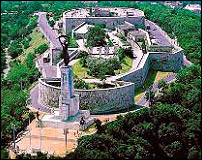
Gellért Hill
Visible from almost everywhere in Budapest, Gellért Hill, with the impressive Freedom Monument on its peak, is one of the city's memorable landmarks.
The 14-metre monument was originally commissioned by Miklós Horthy as a memorial to his son, who died in a wartime air accident.
When the Russians arrived, they replaced the propeller that the figure was originally meant to hold aloft with a palm frond to symbolize the country's liberation from the Nazis.
Just beyond the monument is the Citadella, a fortress constructed by the Habsburgs following the 1848-1849 war of independence.
It now houses an open-air museum chronicling the history of the hill.

The Chain Bridge
The Chain Bridge was the first permanent link between Buda and Pest and is a fitting monument to István Széchenyi - known as the 'Greatest Hungarian'.
The bridge has a British connection too: it was designed by William and constructed by Adam Clark, after whom the roundabout on the Buda side is named.

Margaret Island
Budapest's playground, car-free Margaret Island has everything you need to enjoy a relaxing day - including sport stadium, numerous tennis courts, outdoor swimming complex, an open air theatre, Japanese and Rose gardens, early medieval ruins, two spa hotels and a beer garden.
PEST

Parliament
The world's second largest parliament building is a postcard favorite, particularly when reflected in the River Danube below it.
It is equally lavish on the inside, but tourists must be part of an organized sightseeing tour to enter.

St Stephen's Basilica
Named after Szent István (St Stephen) founder of the Hungarian Christian state, the basilica is visible from all over Budapest.
The dome, at 315 ft is the exact height as that of the Parliament, whose builders decided not to go higher.

The Great Synagogue
This synagogue is the second largest in the world (after the one in New York).
It has three naves and following orthodox tradition, separate galleries for women.
Together the naves and galleries can accommodate up to 3,000 worshippers.
It is also a focal point of Budapest's thriving Jewish community, which holds an annual festival in and around the impressive building.
The Jewish Museum can also be find here, and the Holocaust Documentation and Memorial Centre is an important and powerful reminder of some of the darkest periods in European history.

Andrássy Avenue
It was named after the former prime minister who had done much to make Budapest a true metropolis.
Andrássy was determined to keep the architectural integrity of Budapest to include elegant thoroughfare to emulate Paris's Champs Elysees.
The cream of Eclectic architecture is to be seen along the Avenue including the outstanding Opera House and many beautiful tenement blocks with intimate inner courtyards, statues and fountains.
One of the special features of Andrássy Avenue is barely visible on the surface.
The only give-away is the occasional wrought iron balustrade leading underground.
Europe's first sub-surface railway was built under the road, and the more than 125 year old underground is still carrying passengers today along a line only slightly longer than the original.

Heroes' Square
The statues on Heroes' Square are very much a who's who of Hungarian history (with the notable exception of the unpopular Habsburg monarchy, whose statues were removed and replaced) and its scale and grandeur is an indication of the pride Hungarians have for their country.
Behind it, City Park offers a host of attractions of its own, including the fairy tale Vajdahunyad Castle, the Zoo and the obligatory Széchenyi Bath.
Travel to the country side
North-Eastern Hungary, Eger & Tokaj

If you leave Budapest towards the East and drive along the bordering region of the Great Hungarian wine country, after one and a half hours driving you will arrive to the city of Eger, located in a valley between the Mátra and Bükk Mountains.
It is a 1000 year old Episcopal seat today, an archiepiscopal center with a glorious historical past.
István Dobó, one-time castellan, gave the town the title “patriotic town” for its month long resistance in 1552 against Ottoman Turkish forces that had a superiority of 20 - times against Dobo’s small army.
Eger has many attractions beside the fortress: medicinal baths, historical monuments and fine wines.
Another famous product of the region is Bull’s Blood, the legendary full bodied red wine, a cuvee of red grapes.
The mystery around the wine is kept secret, but if you are curious, come and visit Eger to find it out! You have to take a historical walk in the mediaeval castle and walk the old town.
Great place to have lunch and wine tasting.
See unique wine cellars dug into the hillside standing next to each other in close succession.
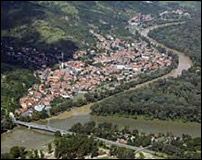
Heading further to the East, you pass by Mezõkövesd, a settlement that is famous for its folk’s art.
The next place to visit is the town of Tokaj, where the world-famous Tokaji Aszú is produced.
It is the most famous wine producing region in Hungary, also well known outside Hungary among wine lovers.
Even though the viticulture in this area is a thousand years old, it became world famous only in the 17th century, when the Tokaji Aszú, a remarkable rare phenomenon resulting from typically late harvesting and special manufacturing processes, achieved wide recognition.
As its fame grew, it reached more and more people.
The Tokaji Aszú was awarded the title of "The king of wines, the wine of kings" in the court of Louis 14th, but was also well-liked by the court of the Tsar and by the Polish nobility.
In Tokaj, go visit the famous Rákóczi Wine Cellar.
Here you can do a cellar visit with a professional guide that will explain everything about the production and background of this famous wine.
Eastern Hungary, Debrecen & Hortobágy
Populated by nearly 240,000 inhabitants, Debrecen is one of the biggest cities in eastern Hungary and the third largest city of Hungary.
Situated 225 Km from Budapest, these areas are easily reachable by train.
It is also the center of Hungarian Protestant faith in Hungary.
Both cities are surrounded by the pallag forests.
Debrecen offers a host of charming cafés and shops along the main boulevard.
Debrecen is a quiet city which preserves traditions in folk music, art and culture.
Churches and historic university are very famous for their architectural characteristics.
Restaurants serve typical Hungarian food like “töltött paprika”, “töltött káposzta” and “gulyás” at very reasonable prices.
The city is also known for its bakeries, pancakes and ice cream.
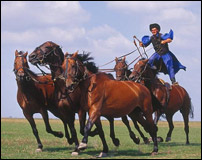
Hortobágy is a village in Hajdú – Bihar County in Hungary, and is located 35 km west of Debrecen.
This is Hungary's largest protected area to include the largest natural grasslands in Europe.
Hortobágy has been described a grassy plain with cattle, sheep, oxen, and horses, tended by herdsmen.
It provides habitat for various different species.
The over 800 km² region is part of the World Heritage.
The Hortobágy National Park is the first nature reserve in Hungary with more than 230 protected bird species.
Several hundred thousand tourists are attracted by the sights of intact nature every year.
Goulash competition, Shepherds' meeting in the Animal park, Mátán Shepherds' Festival and Hortobágy Equestrian Days are connected with Whitsun.
The village day is held on June 2nd of each year.
Shaman Day is organized on June 23d, the Bridge Fair is held between 18th and 20th of August and finally the County Hunters' Day is held August 25th.
South-Eastern Hungary

Gyula with its busy tourism is one of the most popular resort towns of Hungary; the center of tourism is Békés.
The town is ideal for relaxation due to its pleasant climate, and shady parks.
It is one of the most important cultural centers south of the Great Plain.
Gyula is rich in monuments and the relics of the historical past.
The main attraction of the town is the Castle Bath established in the 8.5 ha primeval park.
In 1985 it was classified as a medicinal bath and with its 19 pools, it was awarded the classification of a four-star - the highest category - open-air and medicinal bath by the Hungarian Association of Baths.
Next to the Bath you can find the other main attraction of Gyula from the 15th century.
It has the only intact Gothic brick castle of Central and Eastern Europe built in a flat area.
The castle museum is open to the public again.
Downstairs you can find the castle prison, a larder, a baking house, a blacksmith´s workshop, a pottery workshop, which is also a museum pedagogical room, a wine bar and a chapel.
South Hungary

If you leave Gyula and drive west for about one hour drive, you will be in Szeged, which is situated in the southern part of Hungary and is home to approximately 162,000 inhabitants.
The city’s university is one of the best in the country and among the top rated in Europe.
Szeged enjoys a pleasant climate with many sunny days throughout the year; it has been nicknamed ‘the city of sunshine’.
The Szeged Open-air Festival, organized in Dome Square in front of the Votive Church from the 1930s, is still the most outstanding cultural event of the town in July and August.
University institutions, Episcopal seat and Theological Academy are housed in the surrounding buildings.
The oldest monument of the town is the Dömötör Tower, part of a former, 12th century church, is now used as a baptistery.
On the order of the local Catholic Serbs, the Serbian church was completed in 1778.
The Kárász House was built in neo-classical style in 1845, from its balcony; the last speech of Lajos Kossuth in Hungary was delivered on 12th July, 1849.
The Our Lady church was built in the 15th century on the site of a former church from the age of the árpád.
To the net vaulted nave, a stellar vaulted chancel was added in 1503.
It is one of the finest examples of mature Gothic architecture in Hungary.
Eminent Hungarians born in Szeged include poet Gyula Juhász and composer Jenõ Huszka.
At Szeged University, former alemni include Professor Albert Szent-Györgyi.
He is famous for developing a modern method of vitamin C production that landed him the prestigious Nobel Prize.
From the vast number of sights offered by the town the Móra Ferenc Museum, the Salami and Paprika Museum, the Castle Museum and the Observatory are a must to see.
Other places of natural interest include the Botanical Garden, the Game Park, Lake Fehér and the Sas Creek.
South-Western Hungary, Pécs
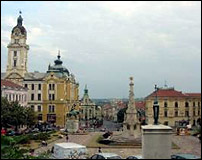
Driving from Szeged to Pécs is about two hours.
Pécs have a Mediterranean atmosphere and are a treasure-house of science, and arts.
This city has been destroyed several times by war over the centuries.
You will be able to see the architecture influence from the Romans, Middle Ages, Turkish occupation and much more.
The development of the middle-class are influenced by gothic, renaissance, baroque dwelling houses, Christian churches Islamic houses of prayer, minarets, baths and public buildings.
After the period of migration, St. Stephen founded an episcopate in Pécs around 1009.
Due to the economic and cultural development of the settlement, Pope Urban signed the foundation document of the university during the reign of Lewis the Great, in 1367.
Soon after the town of Pécs became the seat of the first university of Hungary.
The University of Pécs is still a dominant cultural and scientific centre.
Also prominent tourist attractions are the Zsolnay ceramics factory, the Littke champagne and the Angster organ.
The city of Pécs mainly attracts visitors owing to its intellectual life, cultural, historical relics and its special style.
It will deservedly bear the title "the Cultural Capital of Europe" in 2010.
It is famous in Europe for its museums, rich art life, art festivals and artists.
Outstanding museums of Pécs include the Treasury of the Basilica of Pécs, Janus Pannonius Museum, Exhibition of Ethnography, Csontváry Museum, Vasarely Museum, Amerigo Tot Exhibition, Museum of Natural Sciences, Modern Hungarian Gallery I and II, galleries.
Pécs also host the National Theatre Festival.
Thousands of tourists like the famous wines of the Mecsek hills.
Western Hungary
Western Hungary has something to offer to every type of traveler: thermal pools and wellness facilities, historically preserved towns with architectural and artistic monuments, excavations and museums as testimonies of a great past, full calendars of events, Hungarian culinary specialties and many other things.

Lake Balaton is the largest lake in central Europe with an area of 592 square km and a length of 77km (48 miles).
Its shores are lined with resorts.
The lake is quite shallow and is narrowest at the peninsular of Tihany with its Baroque abbey.
Its southern shore is sandy and shallow, with many beaches ideal for families.
The northern shore is steeper and backed by hills with hiking paths and biking trails.
The most picturesque area is the Tihany peninsula on the northern side.
A Baroque Bendictine Abbey is its major attraction, in addition to the many large homes surrounded by gardens.
Siófok is the main resort.
It lies at the end of the M7 Motorway from Budapest and has frequent train service.
It is also a terminal for the lake steamers that criss-cross the lake in summertime.
Close by is Balatonföldvár with beautiful flower gardens.
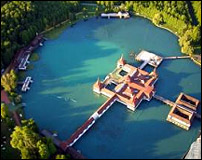
At the south-west end of the lake, Keszthely is home to the Festetics family palace.
The central wing of the 360 room Baroque palace and museum.
It is surrounded by an extensive, well kept park in the English style.
Only 6 km from Keszthely, at Héviz.
You may bathe in Europe's largest natural hot water lake.
The water is continually replenished by a spring, so that even in winter the water temperature stays close to 20C (72F).
The water-lilies thrive in this environment.
About half hour drive to west you will be in Szombathely which is another ancient Roman colony, but only fragments of the Roman ruins remain today.
A complete village museum has been built by bringing original farm homes from all over the region.
The Synagogue is a remarkable structure combining many architectural elements from gothic Europe and the East.
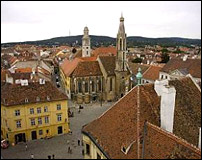
Driving 45 minutes up north, there is Sopron one of the most important holiday and tourist resorts of Hungary.
The image of the inner town is still dominated by the several medieval churches, the houses of medieval origin with gables and spacious courtyards and the narrow streets.
There are fascinating 13th and 14th century houses and churches for the enthusiasts of Gothic architecture.
The Fire-watch Tower, the symbol of the town, was given its present form after the fire of 1676.
In the Main Square the Storno House and the exhibition can be seen, while in Orsolya Square the Lábasház (Arcaded House) is worth visiting.
The Saint Ursula's church with the nunnery and the school were built in Romantic style in the last century.
The Esterházy, Erdõdy, Széchenyi and Zichy-Meskó mansions depict Sopron as a highly popular place of residence among the families of Hungarian aristocracy.
Also visitors should not miss tasting Kékfrankos, the famous Sopron wine.
Pretty close to Sopron there is Fertõd a small town near the Austrian border worth visiting to see the magnificent Rococo palace built by Prince Miklós Eszterházy in the 18th century.
Here Haydn composed and conducted many of his best works.
Once again, concerts are performed in the restored palace chamber.

North-Western Hungary
If you leave Sopron toward Budapest, you should stop by Gyõr.
Although Gyõr is a modern industrial city, its ancient core is well preserved around the old Market Square.
The square and the neighboring streets are lined with beautiful medieval and Baroque houses, including the Esterhazy Palace.
The cathedral, on top of the hill, is a mixture of styles having been continuously enlarged since the 11th.Cent.
A festival of concerts, drama and ballet is held in June.
Only 18km from Gyõr lays the 1,000 year old Benedictine Abbey of Pannonhalma.
Remains of the original walls and crypt built in 997 lie beneath the present structure of the Basilica, located on top of the hill with a commanding view.
A Mass with Gregorian chants takes place at 10 o'clock, every Sunday.

If you keep going in the direction to Budapest it is worthwhile to visit in Esztergom.
There you can see Hungary's largest Basilica, which are the houses of a treasury of 1,000 year old historic relics.
This was also the birthplace of St. Stephen and the first capital of the new country.
The 12th Century palace is open for tours.
From the top of the cupola of the Basilica, you can enjoy a wonderful view of the Danube Bend and the distant mountains of Slovakia.
In summer you can make a day trip from Budapest on a river boat.
|